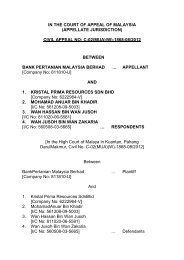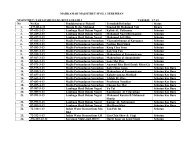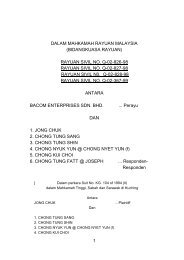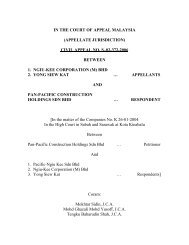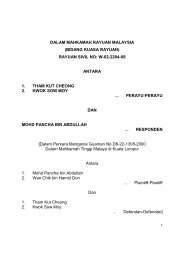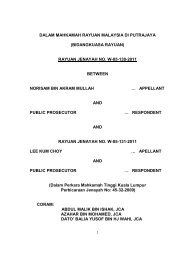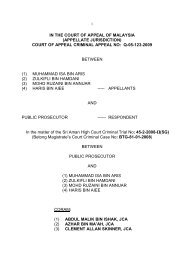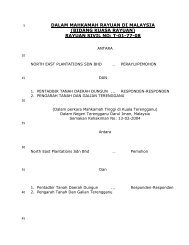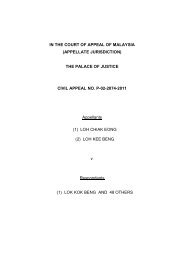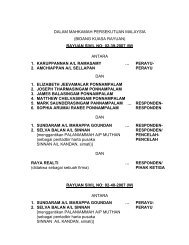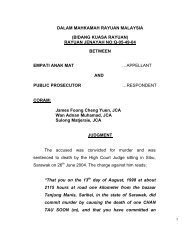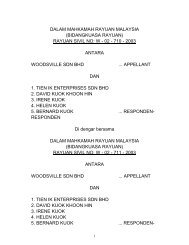CIVIL APPEAL NO.: 02(i)-8-03/2012(J) BETWEEN 1. JOSEPH B
CIVIL APPEAL NO.: 02(i)-8-03/2012(J) BETWEEN 1. JOSEPH B
CIVIL APPEAL NO.: 02(i)-8-03/2012(J) BETWEEN 1. JOSEPH B
You also want an ePaper? Increase the reach of your titles
YUMPU automatically turns print PDFs into web optimized ePapers that Google loves.
IN THE FEDERAL COURT OF MALAYSIA AT PUTRAJAYA<br />
(APPELLATE JURISDICTION)<br />
<strong>CIVIL</strong> <strong>APPEAL</strong> <strong>NO</strong>.: <strong>02</strong>(i)-8-<strong>03</strong>/<strong>2012</strong>(J)<br />
<strong>1.</strong> <strong>JOSEPH</strong> BIN PAULUS LANTIP<br />
2. MAIRIN @ MARTIN BIN IDANG<br />
3. JASKRI DOYOU<br />
<strong>BETWEEN</strong><br />
4. SAFFAR BIN JUMAT @ BEKLIN BIN JUMAT<br />
5. DATUK MILLER MUNANG<br />
6. GEORGE WINDOM MUNANG ... APPELLANTS<br />
AND<br />
UNILEVER PLC ... RESPONDENT<br />
CORAM:<br />
ARIFIN BIN ZAKARIA, CJ<br />
HASHIM BIN YUSOFF, FCJ<br />
ABDULL HAMID BIN EMBONG, FCJ<br />
ZALEHA BINTI ZAHARI, FCJ<br />
ZAINUN BINTI ALI, FCJ<br />
1
INTRODUCTION<br />
JUDGMENT OF THE COURT<br />
[ 1 ] This is an appeal against the decision of the Court of Appeal dated<br />
13.10.2010 reversing the High Court’s decision in dismissing the<br />
respondent’s striking out application made under O.18 r.19 of the<br />
Rules of the High Court 1980 (“the RHC”). Leave to appeal was<br />
granted by this Court on 7.2.<strong>2012</strong> on the following question:<br />
“Whether the doctrine of res judicata applies to bar an<br />
application under Order 18 Rule 19 where an<br />
application under Order 11 of the Rules of the High<br />
Court is dismissed on similar grounds”.<br />
[ 2 ] In this judgment, the appellants will be referred to as the plaintiffs<br />
and the respondent as the 4 th defendant, as they were in the High<br />
Court.<br />
THE FACTS<br />
[ 3 ] This appeal originated from a suit against four defendants<br />
including the 4 th defendant. The plaintiffs are the shareholders of<br />
a local public company known as Unitangkob (M) Berhad<br />
(“Unitangkob”), formerly known as Pelangi Jadi Sdn. Bhd.<br />
[ 4 ] All the four defendants are companies. The 4 th defendant owns the<br />
2 nd and 3 rd defendants, which in turn own the 1 st defendant. The<br />
plaintiffs alleged that all the defendants companies operated under<br />
2
the same group of company, in which the 4 th defendant is<br />
ultimately the controlling mind and will of the other companies.<br />
[ 5 ] The 1 st and 2 nd defendants are both private limited companies<br />
registered in Malaysia. The 3 rd defendant is a private limited<br />
company while the 4 th defendant is a public listed company, both<br />
were incorporated and having their registered address in England.<br />
[ 6 ] In 1995, the 4 th defendant offered a joint venture in its palm oil<br />
business in Sabah to the plaintiffs. Pursuant to that, the plaintiffs<br />
entered into two agreements. The first was a Shareholder<br />
Agreement with the 1 st , 2 nd and 3 rd defendants. The second was a<br />
Share Sale Agreement with the 1 st defendant. Both agreements<br />
were to regulate the joint venture between them. The 4 th defendant<br />
was never a party to any of the agreements.<br />
[ 7 ] Disputes then arose between the parties to the joint venture. On<br />
4.12.20<strong>02</strong>, the plaintiffs filed a civil suit in Johor Bahru High Court<br />
against all the defendants premised upon three causes of action<br />
namely; breach of contract, misrepresentation and tort of<br />
conspiracy to defraud.<br />
[ 8 ] As the 3 rd and 4 th defendants are companies registered in England,<br />
it is a requirement under O.11 r.1 of the RHC that the service of<br />
the writ of summons is only permissible with leave of the court. On<br />
2<strong>1.</strong>3.20<strong>03</strong>, leave to issue and serve the Concurrent Writs and the<br />
Notice of Writs out of jurisdiction against the 3 rd and 4 th defendants<br />
was granted by the court. The writs were duly served on the 3 rd<br />
and 4 th defendants in England.<br />
3
Application for setting aside the leave for service out of jurisdiction<br />
[ 9 ] The 3 rd and 4 th defendants then filed an application under O.12 r.7<br />
of the RHC to set aside the leave obtained by the plaintiffs for<br />
service out of jurisdiction. The application was dismissed by the<br />
Deputy Registrar of the High Court on 17.8.2004. They appealed<br />
to the Judge in Chambers. One of the grounds of the appeal was<br />
non-compliance with O.11 r.4(1) of the RHC for failing to<br />
demonstrate a prima facie case against them.<br />
[10] In dismissing the appeal, Syed Ahmed Helmy J had this to say:<br />
“Upon evaluating the affidavit evidence herein I am of<br />
the considered view, as submitted by learned Counsel<br />
for the Plaintiff, that the Plaintiff’s case falls within any<br />
one of limbs (f), (h) and (j) of Order 11 rule 1 Rules of<br />
the High Court 1980...”<br />
[11] Later, at p.7 of his judgment, it was held as follows:<br />
“From the plea aforesaid it is also clear that the<br />
Plaintiff’s claim herein is founded upon both the<br />
Shareholders Agreement and the Share Sale<br />
Agreement and that the 3 rd Defendant is a party to the<br />
Shareholders Agreement. Hence the issue of whether<br />
or not the 3 rd Defendant has any material obligations<br />
with respect to the Shareholders Agreement will<br />
invariably be an issue to be determined during the<br />
course of the action.<br />
4
Moreover, as the Plaintiffs are claiming that the 3 rd and<br />
4 th Defendants are joint tortfeasors with the 1 st and 2 nd<br />
Defendants in the tort of conspiracy, it is clear that the<br />
3 rd and 4 th Defendants are necessary parties to the<br />
present action”<br />
[12] Then at p.9, he held this:<br />
“Here the claim is for conspiracy to injure and defraud.<br />
The claim is premised on the use of the Shareholders<br />
Agreement and the Share Sale Agreement as an<br />
instrument of fraud coupled with the conduct of<br />
representatives of the Defendants. The only way in<br />
which the Plaintiffs can establish their case is through<br />
oral evidence of what occurred at the meetings in<br />
question and the prior conduct of the Defendants.”<br />
Application for striking out<br />
[13] On 20.8.2007, the 3 rd and 4 th defendants filed an application under<br />
O.18 r.19(1) of the RHC, to strike out the writs against them under<br />
limb (b) and (d) for being scandalous, frivolous or vexatious or<br />
otherwise an abuse of process of the court. The application came<br />
before Zakiah Bt Kassim JC, who on 14.<strong>1.</strong>2010, dismissed the<br />
application.<br />
5
[14] It was held by the learned Judicial Commissioner as follows:<br />
“... mahkamah menolak permohonan di Lampiran 104<br />
atas alasan-alasan yang berikut;<br />
(i) Defendan keempat adalah holding company<br />
bagi defendan pertama, kedua dan ketiga.<br />
Defendan keempat hanya menjual<br />
kepentingannya dalam defendan kedua pada<br />
tahun 2000.<br />
(ii) Pada tahun 1995; defendan keempat telah<br />
menawarkan perjanjian joint-venture kepada<br />
plaintif dan perjanjian jualan saham dan<br />
pemegang saham telah ditandatangani.<br />
(iii) Mahkamah mendapati bahawa defendan<br />
keempat yang mengawal defendan pertama dan<br />
kedua. Semua defendan bertindak sebagai<br />
suatu kumpulan dan semua defendan telah<br />
memungkiri perjanjian usahasama tersebut.<br />
(iv) Mahkamah mendapati isu duplicity tidak<br />
berbangkit kerana pihak-pihak dalam guaman<br />
Kota Kinabalu dan Johor Bahru adalah berbeza.<br />
Defendan ketiga dan keempat bukanlah pihak<br />
kepada guaman Kota Kinabalu.<br />
6
The Court of Appeal<br />
(v) Memandangkan permohonan untuk meminda<br />
pernyataan pembelaan belum diputuskan lagi,<br />
maka adalah pra matang bagi mahkamah ini<br />
membenarkan permohonan defendan untuk<br />
membatalkan tuntutan plaintif terhadap<br />
defendan ketiga dan keempat.”<br />
[15] Being dissatisfied with the dismissal of their striking out<br />
application, the 3 rd and 4 th defendants appealed to the Court of<br />
Appeal. The 3 rd and 4 th defendants contended that they were never<br />
a party to the agreements with the plaintiffs. The agreements were<br />
only between the 1 st and 2 nd defendants and the plaintiffs. The 3 rd<br />
and 4 th defendants maintained that they were separate legal<br />
entities from the 1 st and 2 nd defendants.<br />
[16] On 13.10.2010, the Court of Appeal unanimously allowed the<br />
appeal by the 4 th defendant but dismissed the appeal by the 3 rd<br />
defendant. Consequently, the writ against the 4 th defendant was<br />
struck out. The action against the 3 rd defendant and the other<br />
defendants is still pending at the High Court.<br />
The Federal Court<br />
[17] The plaintiffs sought leave to appeal to the Federal Court against<br />
the Court of Appeal’s decision in allowing the 4 th defendant’s<br />
7
appeal. Leave was obtained on 7.2.<strong>2012</strong> on the question alluded<br />
to earlier.<br />
[18] The crux of the appeal is on the issue, whether the test to be<br />
adopted by the court in striking out applications under O.18 r.19(1)<br />
of the RHC is similar to the test for leave application for service out<br />
of jurisdiction under O.11 r.4(1) of the RHC. If the answer is in the<br />
affirmative, the next question is whether the doctrine of res judicata<br />
applies in the circumstances of this case.<br />
[19] Learned counsel for the plaintiffs argues that the operative words<br />
in O.11 r.4(1) of the RHC for leave for service out of jurisdiction<br />
and in O.18 r.19(1) of the RHC for striking out application, are the<br />
same or substantially the same. Therefore, the test to be adopted<br />
by the court in assessing these two applications must be the same.<br />
Hence, he contends that when the 4 th defendant failed in its<br />
application under O.12 r.7 of the RHC, it is then barred by the<br />
doctrine of res judicata to apply for striking out under O.18 r.19 (1)<br />
of the RHC since the same issue or issues had been adjudicated<br />
upon by the court. In other words, the 4 th defendant can only<br />
choose either to apply for setting aside the leave under O.12 r.7 of<br />
the RHC or to apply for striking out under O.18 r.19(1) of the RHC.<br />
Once its application to set aside the leave under O.12 r.7 of the<br />
RHC failed, it is precluded from making any further application<br />
under O.18 r.19(1) of the RHC.<br />
8
[20] To support his contention, learned counsel for the plaintiffs<br />
referred us to the following cases:-<br />
(i) MBf Holdings Bhd. & Anor v. Deutsche Bank (Malaysia)<br />
Bhd. & Anor (unreported Kuala Lumpur High Court civil suit<br />
no. D3-22-398-2008), where Nallini Pathmanathan J in<br />
assessing the application to set aside the leave for service<br />
out of jurisdiction under O.11 r.4(1) of the RHC, had applied<br />
the test of a “good arguable cause of action”.<br />
(ii) Bandar Builder Sdn. Bhd. & 2 Ors. v United Malayan<br />
Banking Corporation Bhd. [1993] 3 MLJ 36, where the<br />
Supreme Court in assessing the application for striking out<br />
under one of the four limbs of O.18 r.19(1) of the RHC, had<br />
endorsed the tests of whether the case or claim is “obviously<br />
unsustainable ... there is no reasonable cause of action or<br />
that the claims are frivolous or vexatious or that the defences<br />
raised are not arguable... pleadings have raised some issues<br />
which require serious discussion.”<br />
[21] Learned counsel for the plaintiffs further submits that the position<br />
under English law is no different from ours. In determining whether<br />
a plaintiff has sufficient grounds to obtain leave for service out of<br />
jurisdiction, the English courts have applied the assessment as to<br />
the strength of the case. In so doing, the English courts have<br />
alternated between the phrases “good probable cause of action”,<br />
“prima facie case” and “good arguable case”. To support, they<br />
referred us to the case of Tyne Improvement Commissioners v.<br />
Armement Anversois S/A (The Brabo) [1949] AC 326;<br />
9
Vitkovice Horni A Hutni Tezirstvo v. Korner [1951] AC 869; and<br />
Societe Commerciale De Reassurance v. Eras International<br />
Ltd. (formerly Eras (U.K.) ) & Others. (The Eras Eil Actions)<br />
[1992] 1 Lloyds Rep 570.<br />
[22] In reply, learned counsel for the 4 th defendant contends that the<br />
plaintiffs’ argument of res judicata is misconceived in law because,<br />
that issue was never raised and articulated by any party at the<br />
Court of Appeal. The arguments put forth by both parties at the<br />
Court of Appeal were purely on striking out applications under<br />
O.18 r.19(1) of the RHC based on the strength of the pleadings,<br />
whether the claim against the 4 th defendant was frivolous,<br />
vexatious and an abuse of the process of the court. Hence, the<br />
Court of Appeal’s decision was purely on the strength of the claim<br />
and was never decided on the issue of res judicata. In other words,<br />
there was no decision on res judicata to be appealed upon to this<br />
Court.<br />
[23] Learned counsel for the 4 th defendant further submits that the<br />
operative words used in O.11 r.4(1) of the RHC and in O.18 r.19(1)<br />
of the RHC must be read in the context of the respective provision,<br />
independent of each other. In deciding to grant leave for service<br />
out of jurisdiction, the court needs to satisfy itself that it has the<br />
jurisdiction over the foreign defendant by looking at the conditions<br />
set out in O.11 r.4(1) of the RHC, i.e. that in the deponent’s belief,<br />
the plaintiff has a good cause of action. Similarly, in deciding<br />
whether leave ought to be set aside, the court must ascertain<br />
whether the breach complained of in the writ, was within its<br />
jurisdiction.<br />
10
[24] For this purpose, learned counsel for the 4 th defendant contends<br />
that the court must assume all the facts alleged in the statements<br />
of claim are true and there is no further duty on the plaintiff to<br />
adduce evidence to prove the claim. The plaintiff is simply required<br />
to aver that in his belief, he has a good cause of action within the<br />
jurisdiction. The court has to decide whether it could exercise<br />
jurisdiction over the foreign defendant and not whether the plaintiff<br />
has a sustainable claim.<br />
[25] The basis for his argument is founded in the case of Matchplan<br />
(Malaysia) Sdn & Anor v. William D Sinrich & Anor [2004] 1<br />
CLJ 810, where Gopal Sri Ram JCA (later FCJ) in delivering the<br />
majority judgment of the court said at p.819:<br />
“It is elementary law that for the purpose of<br />
determining whether the High Court at Kuala Lumpur<br />
has jurisdiction over the defendants, the allegations<br />
made by the plaintiffs in their statement of claim must<br />
be assumed to be true. Thus, in Vanity Fair Mills Inc v.<br />
T Eaton Co Ltd [1956] 25 CPR 6 Waterman J<br />
observed as follows:<br />
Although the parties presented many<br />
affidavits, depositions, and exhibits for the<br />
consideration of the district court, there has<br />
been no trial of facts, and the complaint is<br />
unanswered. On an appeal from a judgment<br />
granting a motion to dismiss a complaint for<br />
11
lack of federal jurisdiction, we must assume<br />
the truth of the facts stated in the complaint.<br />
(emphasis added.)<br />
See also Rediffusion (Hong Kong) Ltd v. A-G of Hong<br />
Kong [1970] AC 1136 per Lord Diplock.<br />
So too here. The merits of the plaintiffs' claim that<br />
there was publication are yet to be tried. The mere<br />
ipse dixit of the defendant that there was no<br />
publication cannot be determinative of the matter. At<br />
the risk of repetition, it needs to be said that at the<br />
point of determining whether the tort of defamation<br />
was committed within the jurisdiction, all the<br />
allegations in the statement of claim must be<br />
presumed to be true. At that stage there is no<br />
preliminary inquiry through a trial on affidavits as to<br />
whether the defamatory material was indeed<br />
published within the jurisdiction. Were it otherwise,<br />
there is a risk that applications to discharge an order<br />
granting leave under O. 11 r. 1 may turn out to be mini<br />
trials without determining the suit on its merits.”<br />
[26] Further, it was argued for the 4 th defendant that in order to<br />
commence a claim against a foreign defendant, the same<br />
threshold as against a local defendant apply, i.e. that the court<br />
must have jurisdiction over the claim. Once this threshold is<br />
satisfied, only then, would the application for striking out under<br />
O.18 r.19(1) of the RHC be available to the defendant. An<br />
12
application for striking out under O.18 r.19(1) of the RHC can only<br />
proceed on the basis that the court has jurisdiction over the foreign<br />
defendant. To say that once the court has satisfied itself that it has<br />
jurisdiction over the foreign defendant, but the foreign defendant is<br />
then precluded by res judicata from applying for striking out under<br />
O.18 r.19(1) of the RHC, would place the foreign defendant at a<br />
disadvantage over a local defendant.<br />
FINDINGS OF THE COURT<br />
[27] On the first issue, we agree with learned counsel for the 4 th<br />
defendant that under s.96 (a) of the Courts of Judicature Act 1964,<br />
leave should only be granted on an issue decided by the Court of<br />
Appeal. In this case, he submits the issue of res judicata was<br />
never canvassed before the Court of Appeal and hence the appeal<br />
ought to be dismissed in limine. Our answer to this is found in the<br />
judgment of Zaki Azmi CJ in Terengganu Forest Products Sdn<br />
Bhd v. Cosco Container Lines Co Ltd & Anor and other<br />
applications [2011] 1 MLJ 25 where at page 50, he said:<br />
“... once leave is granted the appellate panel should<br />
not again consider whether leave should or should not<br />
have been given unless that leave was erroneously<br />
granted because certain established law or statute<br />
which would lead the court hearing the appeal to<br />
dismiss the appeal in limine was not brought to the<br />
attention or overlooked by the leave panel. Also, to<br />
use the word of Abdul Hamid Mohamad JCA in<br />
13
Raphael Pura v. Insas Bhd & Anor [20<strong>03</strong>] 1 MLJ 513,<br />
‘It is res judicata’. The appellate panel should respect<br />
the leave panel and just proceed to hear the appeal,<br />
even if the appeal is groundless.”<br />
We agree with the view expressed therein that once leave had<br />
been granted by a panel of this Court, it should not be reviewed by<br />
another panel hearing the appeal except in the limited<br />
circumstances as stated by Zaki Azmi CJ. This case does not fall<br />
within that limited circumstances which warrant us to reconsider<br />
the leave granted by another panel of the Court.<br />
[28] We will now consider the merits of the appeal before us. The<br />
narrow issue raised in this appeal is whether the doctrine of res<br />
judicata would apply so as to bar the application under O.18<br />
r.19(1) of the RHC, in the circumstances where an application by a<br />
party to set aside the leave for service out of jurisdiction under<br />
O.12 r.7 of the RHC had earlier been dismissed by the court.<br />
Res Judicata<br />
[29] What is meant by res judicata was well explained in Asia<br />
Commercial Finance (M) Berhad v. Kawal Teliti Sdn. Bhd.<br />
[1995] 3 CLJ 783, where Peh Swee Chin FCJ in delivering the<br />
judgment of the Court stated:<br />
“What is res judicata? It simply means a matter<br />
adjudged, and its significance lies in its effect of<br />
14
creating an estoppel per rem judicature. When a<br />
matter between two parties has been adjudicated by<br />
a Court of competent jurisdiction, the parties and<br />
their privies are not permitted to litigate once more<br />
the res judicata, because the judgment becomes the<br />
truth between such parties, or in other words, the<br />
parties should accept it as the truth; res judicata pro<br />
veritate accipitur. The public policy of the law is that<br />
it is in the public interest that there should be finality<br />
in litigation - interest rei publicae ut sit finis litium. It<br />
is only just that no one ought to be vexed twice for<br />
the same cause of action - nemo debet bis vexari<br />
pro eadem causa. Both maxims are the rationales<br />
for the doctrine of res judicata, but the earlier maxim<br />
has the further elevated status of a question of<br />
public policy.”<br />
See also the case of Kandiah Peter A/L Kandiah v. Public Bank<br />
Bhd. [1993] 4 CLJ 332.<br />
[30] Thus, for the doctrine of res judicata to apply, the same issue must<br />
have been raised and decided in an earlier proceeding or action in<br />
which the parties are represented. And for that reason, it is not<br />
open for the same issue to be litigated afresh between the same<br />
parties. This doctrine is based on the public policy that there must<br />
be finality and conclusiveness in judicial decisions and the right of<br />
the individual from being vexed by multiplicity of suits at the<br />
instance of an opponent. In Satyadhyan Ghosal and others v.<br />
Smt. Deorajin Debi and another 1960 AIR S.C. 941, the Indian<br />
Supreme Court stated the principle as follows:<br />
15
“(7) The principle of res judicata is based on the need<br />
of giving a finality to judicial decisions. What it says is<br />
that once a res is judicata, it shall not be adjudged<br />
again. Primarily it applies as between past litigation<br />
and future litigation. When a matter – whether on a<br />
question of fact or a question of law – has been<br />
decided between two parties in one suit or proceeding<br />
and the decision is final, either because no appeal<br />
was taken to a higher court or because the appeal<br />
was dismissed, or no appeal lies, neither party will be<br />
allowed in a future suit or proceeding between the<br />
same parties to canvass the matter again.”<br />
[31] In Henderson v. Henderson [1843] 3 Hare 100, 67 ER 313,<br />
Vigram VC expressed the view that “The plea of res judicata<br />
applies not only to points upon which the court was actually<br />
required by the parties to form an opinion and pronounce a<br />
judgment, but to every point which properly belonged to the<br />
subject of litigation, and which the parties exercising reasonable<br />
diligent, might have brought forward at the time.” This statement<br />
came to be known as the rule in Henderson v. Henderson.<br />
16
[32] In Hartecon JV Sdn Bhd & Anor v. Hartela Contractors Ltd<br />
[1996] 2 MLJ 57, Gopal Sri Ram JCA (later FCJ) observed that:<br />
“We cannot over emphasize the proposition that once<br />
a judge makes a ruling, substantive or procedural,<br />
final or interlocutory, it must be adhered to and may<br />
not be reopened willy-nilly.”<br />
The parties are bound by the rulings of the court under the<br />
principle of res judicata. It is also important to observe that a<br />
decision given by a court at one stage on a particular issue is<br />
binding on it at a later stage in the same or subsequent suit.<br />
[33] In the present case, counsel for the plaintiffs submit that having<br />
failed in its bid to set aside the leave granted under O.11 r.4(1) of<br />
the RHC, the 4 th defendant is barred by the doctrine of res judicata<br />
from applying to strike out the action under O.18 r.19(1) of the<br />
RHC on the ground that the test to determine whether or not leave<br />
under O.11 r.4(1) of the RHC should be granted is the same or<br />
substantially the same as the test to determine whether or not the<br />
claim ought to be struck out under O.18 r.19(1) of the RHC.<br />
[34] As observed above, for res judicata to apply, the issue in the<br />
second or subsequent application must be the same with the issue<br />
decided earlier by the court. Therefore, rightly the documents<br />
relating to the two applications under O.11 and O.12 of the RHC<br />
properly ought to have been placed before us. Unfortunately this<br />
was not done. We can appreciate why this is so, as the appeal<br />
17
efore the Court of Appeal was an appeal against the High Court<br />
Judge’s decision in dismissing the 4 th defendant’s application<br />
under O.18 r.19(1) of the RHC. So, to that extent, we are<br />
handicapped in our deliberation. However, going by the<br />
submission of counsel for the plaintiffs, his contention is that the<br />
test applicable in the two earlier applications are the same or<br />
similar to the test applicable in the O18 r.19(1) of the RHC<br />
application, therefore, the 4 th defendant is estopped from making<br />
the application under O.18 r.19(1) of the RHC as it is bound by<br />
earlier decisions of the court on the same or similar issue.<br />
Service of Writ Out of Jurisdiction<br />
[35] Service of writ out of jurisdiction is governed by O.11 of the RHC<br />
and the cases in which leave may be granted are set out in O.11<br />
r.1(1) para. (a) to (l). It is a discretionary jurisdiction which must be<br />
exercised with caution and biased against invading the sovereignty<br />
of another state. O.11 r.4 of the RHC provides that:<br />
“Rule 4. Application for, and grant of, leave to<br />
serve notice of writ out of jurisdiction (O 11 r 4)<br />
(1) An application for the grant of leave under rule 1<br />
or 2 must be supported by an affidavit in Form 12<br />
stating the grounds on which the application is<br />
made and that in the deponent's belief, the plaintiff<br />
has a good cause of action, and showing in what<br />
18
place or country the defendant is, or probably may<br />
be found.<br />
(2) No such leave shall be granted unless it shall be<br />
made sufficiently to appear to the Court that the<br />
case is a proper one for service out of the<br />
jurisdiction under this Order.”<br />
[36] Hence, an application under O.11 r.4 of the RHC must be<br />
supported by affidavit stating that in the deponent’s belief the<br />
plaintiff has a good cause of action. R.4 is divided into two parts.<br />
While r.4 (1) relates to the merits of the case, r.4 (2) relates to the<br />
discretion of the court whether to grant the leave or not. The<br />
burden of proof on the plaintiff under the two sub-para is different.<br />
[37] Lord Simonds in Korner (Supra), a case under O.11 of the<br />
English Rules of Supreme Court 1965 (“the English RSC”) cited<br />
with approval the interpretation of the words “good cause of action”<br />
to mean “good arguable case”. And he further expressed the view<br />
that the plaintiff need not satisfy the court that he is right. His<br />
burden is only to make it “sufficiently to appear... that the case is a<br />
proper one for service out of the jurisdiction under this Order”.<br />
He explained further that the plaintiff may not prove his case<br />
beyond reasonable doubt. The burden which the rule imposes on<br />
the plaintiff is to make it sufficiently appear that the case is a<br />
proper one for service out of jurisdiction while falling short of the<br />
standard of proof which must be attained at the trial.<br />
19
[38] In R. Leslie Deak, sued as personal representative of Nicholas<br />
Lousis Deak (deceased) and Another v. Deak Perera Far East<br />
Ltd. (in liquidation) [1991] 1 HKLR 551 which is a case involving<br />
service out of jurisdiction under O.11 of the English RSC, the<br />
English Court of Appeal held that by good arguable case is meant<br />
a good prospect of success at trial. It does not mean that the<br />
applicant would probably succeed and may be consistent with the<br />
ability of having a good arguable defence.<br />
[39] In Bradley Lomas Electrolok Ltd & Anor v. Colt Ventilation<br />
East Asia Pte Ltd and Ors [1999] 4 SLR 737, the Singapore High<br />
Court expressed the view that in an application for leave under<br />
O.11 of the Singapore Rules of Court which is equivalent to our<br />
O.11, the court is not called upon to try the action or expressed a<br />
premature opinion on its merit.<br />
[40] In Tyne Improvement Commissioners v. Armement Anversois<br />
S/A (The Brabo) [1949] AC 326, the House of Lords expressed its<br />
approval on the test applied by Morton J in Ellinger v. Guinness,<br />
Mahon & Co. [1939] 4 All E.R. 16, 22 that the test to be applied<br />
for O.11 of the English RSC application is whether there is a real<br />
issue between the plaintiff and that party which the plaintiff may<br />
reasonably ask to the court to try. In other words, the claim was<br />
not vexatious or mala fide.<br />
[41] In Seaconsar Far East Ltd v. Bank Markazi Jomhouri Islami<br />
Iran [1993] 4 All ER 456, Lord Goff of Chieveley stated with<br />
approval the speech of Lord Davey on the procedure to be<br />
followed in the O.11 of the English RSC application where he said:<br />
20
“An injunction is sought to restrain the defendants from doing<br />
some act within the jurisdiction. Rule 4 of the same order<br />
[Ord 11] prescribes that the application is to be supported by<br />
evidence stating that in the belief of the deponent the plaintiff<br />
has a good cause of action, and no such leave is to be<br />
granted unless it be made sufficiently to appear to the court<br />
or judge that the case is a proper one for service out of the<br />
jurisdiction under this order. This does not, of course, mean<br />
that a mere statement by any deponent who is put forward to<br />
make the affidavit that he believes that there is a good cause<br />
of action is sufficient. On the other hand, the court is not, on<br />
an application for leave to serve out of the jurisdiction, or on<br />
a motion made to discharge an order for such service, called<br />
upon to try the action or express a premature opinion on its<br />
merits, and where there are conflicting statements as to<br />
material facts, any such opinion must necessarily be based<br />
on insufficient materials. But I think that the application<br />
should be supported by an affidavit stating facts which, if<br />
proved, would be a sufficient foundation for the alleged<br />
cause of action, and, as a rule, the affidavit should be by<br />
some person acquainted with the facts, or, at any rate,<br />
should specify the sources or persons from whom the<br />
deponent derives his information. A more difficult question is<br />
where it is in dispute whether the alleged or admitted facts<br />
will, as a matter of law, entitle the plaintiff to the relief which<br />
he seeks. If the court is judicially satisfied that the alleged<br />
facts, if proved, will not support the action, I think the court<br />
ought to say so, and dismiss the application or discharge the<br />
order. But where there is a substantial legal question<br />
21
arising on the facts disclosed by the affidavits which the<br />
plaintiff bona fide desires to try, I think that the court<br />
should, as a rule, allow the service of the writ. The words<br />
at the end of the order do not, I think, mean more than<br />
that the court is to be satisfied that the case comes<br />
within the class of cases in which service abroad may be<br />
made under the first rule of the order.” (Emphasis added)<br />
[42] From the authorities, it is clear that there should not be a trial on<br />
the affidavits in determining whether the plaintiff has established a<br />
good arguable case. As stated by Gopal Sri Ram JCA in<br />
Matchplan (Malaysia) Sdn & Anor (Supra) for the purpose of<br />
determining whether High Court at Kuala Lumpur has jurisdiction<br />
over the defendants, the allegations of the plaintiffs in the<br />
statement of claim must be assumed to be true. The application for<br />
leave under O.11 r.4 of the RHC should not be turned into a mini<br />
trial. Hence, the primary consideration at the leave stage is<br />
whether or not the court should grant leave to issue the writ out of<br />
jurisdiction, not so much on the merits of the case.<br />
Striking out application under O.18 r.19 of the RHC<br />
[43] The application for striking out pleadings or the endorsements of<br />
any writ is governed by O.18 r.19(1) of the RHC which provides:<br />
22
“Rule 19. Striking out pleadings and indorsements<br />
(O 18 r 19)<br />
(1) The Court may at any stage of the proceedings<br />
order to be struck out or amended any pleading or the<br />
indorsement, of any writ in the action, or anything in<br />
any pleading or in the indorsement, on the ground<br />
that-<br />
(a) it discloses no reasonable cause of action or<br />
defence, as the case may be; or<br />
(b) it is scandalous, frivolous or vexatious; or<br />
(c) it may prejudice, embarrass or delay the fair<br />
trial of the action; or<br />
(d) it is otherwise an abuse of the process of the<br />
Court;<br />
and may order the action to be stayed or dismissed or<br />
judgment to be entered accordingly as the case may<br />
be.”<br />
[44] Since O.18 r.19(1) of the RHC is coercive in nature and is<br />
exercised by summary process, the court exercises this power with<br />
the greatest of care and circumspection and only in the clearest<br />
case. (See “Pleadings: Principles and Practice”, by Sir Jack<br />
Jacob and Iain S. Goldrein, Sweet & Maxwell, 1990, at p.214).<br />
23
This rule is only applicable where, on the face of it, the claim or<br />
defence is “obviously unsustainable”. (See Attorney General of<br />
the Duchy of Lancaster v London and North Western Railway<br />
Company [1892] 3 Ch. 274).<br />
[45] The Supreme Court in Bandar Builder Sdn. Bhd & Ors (Supra)<br />
has fashioned the test to be adopted in striking out application<br />
under any of the four limbs of O.18 r.19(1) of the RHC, as being<br />
whether the “case or claim is obviously unsustainable”, whether<br />
“there is no reasonable cause of action or that the claims are<br />
frivolous or vexatious or that the defences raised are not arguable”<br />
and whether the “pleadings have raised some issues which require<br />
serious discussion”.<br />
[46] The application to strike out in this case was made under O.18<br />
r.19(1)(b) and/or (d) of the RHC. The application was supported by<br />
the affidavit of Yee Chiau Sing, a General Counsel, South East<br />
Asia of the 4 th defendant. The 4 th defendant alleged that the claim<br />
by the plaintiff against them is scandalous, frivolous and vexatious<br />
and/or an abuse of process of the court.<br />
[47] One of the grounds relied upon by the 4 th defendant in support of<br />
the striking out application was that similar allegations were made<br />
in a Kota Kinabalu suit (“KK suit”) filed by the plaintiffs against the<br />
1 st , 2 nd and 3 rd defendants. In the light of that, it was argued that<br />
the claim against the 4 th defendant is unsustainable.<br />
[48] We agree with learned counsel for the 4 th defendant that O.18<br />
r.19(1) of the RHC application involves a different exercise from<br />
that of O.11 of the RHC. In the latter case, the court merely<br />
considers whether it could exercise jurisdiction over the 4 th<br />
24
defendant. Whereas, in the O.18 r.19(1) of the RHC application,<br />
the court needs to consider whether or not, on the merits, the<br />
plaintiffs’ claim is sustainable, vexatious or otherwise an abuse of<br />
the process of court. In the present case, when the High Court<br />
heard the 4 th defendant’s application under O.12 r.7 of the RHC, it<br />
had examined and adjudicated on the issue of whether the<br />
plaintiffs’ claim, assuming it to be true, would attach liability against<br />
the 4 th defendant and that liability is within the territorial jurisdiction<br />
of the court. At that stage, the court did not examine and<br />
adjudicate on the merits of the claim. The learned Judge in<br />
dismissing the 4 th defendant’s application merely considered the<br />
plaintiffs’ allegation as pleaded without the benefit of the 4 th<br />
defendant’s counter allegations as found in the affidavit supporting<br />
the 4 th defendant’s application under O.18 r.19(1) of the RHC. This<br />
is evident in the judgment of the learned High Court Judge in<br />
regard to O.12 r.7 of the RHC application.<br />
[49] In the affidavit in support of the application to strike out the present<br />
suit, it was alleged that the suit was a follow up to the KK suit filed<br />
by the 2 nd defendant against Unitangkob for recovery of a loan<br />
granted by the 2 nd defendant to the plaintiffs to facilitate the<br />
purchase of lands by the plaintiffs. The KK suit is still pending. It is<br />
alleged that, and this is not denied by the plaintiffs, the substance<br />
of the plea contained in the proposed amended defence and<br />
counterclaim in the KK suit mirror the pleadings contained in the<br />
plaintiffs’ statement of claim in the present suit. The 4 th defendant<br />
is not a party to the KK suit. The 4 th defendant further contends<br />
that it is not privy to any agreement between the plaintiffs and the<br />
1 st and 2 nd defendants nor a party to any alleged conspiracy to<br />
25
defraud the plaintiffs. On that premise, the 4 th defendant contends<br />
that the inclusion of the 4 th defendant in the present suit is<br />
frivolous, vexatious and an abuse of the process of the court.<br />
[50] There is nothing before us showing that these same issues were<br />
relied upon by the 4 th defendant in support of its application under<br />
O.12 r.7 of the RHC. Therefore, in the circumstances, we hold that<br />
the 4 th defendant could not be barred, on the ground of res<br />
judicata, from raising these issues in the striking out application.<br />
CONCLUSION<br />
[51] In answering the question posed to us, we have to make one<br />
pertinent observation in that before us, the plaintiffs had not<br />
established or shown that both the applications under O.18 r.19<br />
and O.11 (should actually read O.12 r.7) of the RHC were<br />
premised on similar grounds. Therefore, the question should rightly<br />
be read without reference to the words “on similar grounds”. In the<br />
circumstances, our answer to the question before us should be in<br />
the negative. Accordingly, the appeal is dismissed with costs.<br />
t.t<br />
(TUN ARIFIN BIN ZAKARIA)<br />
Chief Justice of Malaysia<br />
26
Dated : 16 October <strong>2012</strong><br />
Date of hearing : 29 May <strong>2012</strong><br />
Date of decision : 16 October <strong>2012</strong><br />
27
Counsel for the Appellants : <strong>1.</strong> Thakurdas Naraindas Jethwani;<br />
2. Chetan Jethwani;<br />
3. V. Divan; and<br />
4. Oswald Mojingol.<br />
Solicitors for the Appellants : Messrs. Kumar Partnership<br />
Advocates & Solicitors<br />
Suite 12.01 -12.<strong>03</strong><br />
Tingkat 12, Wisma E&C<br />
No. 2, Lorong Dungun Kiri<br />
Damansara Heights<br />
50490 Kuala Lumpur<br />
Counsel for the Respondent : <strong>1.</strong> Dinesh Bhaskaran; and<br />
2. Chai Siew Wan.<br />
Solicitors for the Respondent : Messrs. Shearn Delamore & Co.<br />
Advocates & Solicitors<br />
Tingkat 7,<br />
Wisma Hamzah-Kwong Hing<br />
No. 1, Lebuh Ampang<br />
50100 Kuala Lumpur<br />
28



